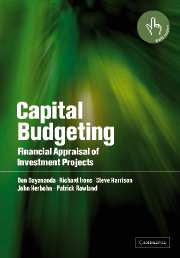Book contents
- Frontmatter
- Contents
- List of figures
- List of tables
- Preface
- 1 Capital budgeting: an overview
- 2 Project cash flows
- 3 Forecasting cash flows: quantitative techniques and routes
- 4 Forecasting cash flows: qualitative or judgemental techniques
- 5 Essential formulae in project appraisal
- 6 Project analysis under certainty
- 7 Project analysis under risk
- 8 Sensitivity and break-even analysis
- 9 Simulation concepts and methods
- 10 Case study in financial modelling and simulation of a forestry investment
- 11 Resource constraints and linear programming
- 12 More advanced linear programming concepts and methods
- 13 Financial modelling case study in forestry project evaluation
- 14 Property investment analysis
- 15 Forecasting and analysing risks in property investments
- 16 Multinational corporations and international project appraisal
- References
- Index
11 - Resource constraints and linear programming
Published online by Cambridge University Press: 14 May 2010
- Frontmatter
- Contents
- List of figures
- List of tables
- Preface
- 1 Capital budgeting: an overview
- 2 Project cash flows
- 3 Forecasting cash flows: quantitative techniques and routes
- 4 Forecasting cash flows: qualitative or judgemental techniques
- 5 Essential formulae in project appraisal
- 6 Project analysis under certainty
- 7 Project analysis under risk
- 8 Sensitivity and break-even analysis
- 9 Simulation concepts and methods
- 10 Case study in financial modelling and simulation of a forestry investment
- 11 Resource constraints and linear programming
- 12 More advanced linear programming concepts and methods
- 13 Financial modelling case study in forestry project evaluation
- 14 Property investment analysis
- 15 Forecasting and analysing risks in property investments
- 16 Multinational corporations and international project appraisal
- References
- Index
Summary
So far we have assumed that the firm's market value or the shareholders' wealth is maximized by accepting every investment project that has a positive NPV. In the real world, however, there are limitations on the investment programme that prevent the firm from undertaking all such projects. There may, for example, be a limit on the amount of funds available for financing investment projects. This is often called capital rationing.
Clearly, capital rationing does exist in the real world. If projects have positive NPVs and both management and financiers are happy with the NPV estimates, then, in an efficient capital market, one would expect funds to be available for all positive NPV projects. Under these circumstances, capital rationing is irrational. Nevertheless, two types of capital rationing are often encountered. Sometimes, management imposes capital expenditure limits; this is called soft capital rationing. Sometimes, a firm is unable to raise funds to undertake all positive NPV projects, and this is referred to as hard capital rationing. Various reasons have been advanced as to why hard or soft capital rationing might exist (Weingartner, 1977).
Apparently viable projects can also be rejected because firms face various other resource constraints, such as the availability of particular types of labour and raw material. Government regulations or marketing strategies may also impose restrictions. Specific methods such as the profitability index, which involve ‘juggling’ positive NPV project expenditures to ensure that total combined NPV is maximized from the investment decision, can handle decisions associated with a single constraint.
- Type
- Chapter
- Information
- Capital BudgetingFinancial Appraisal of Investment Projects, pp. 204 - 218Publisher: Cambridge University PressPrint publication year: 2002



